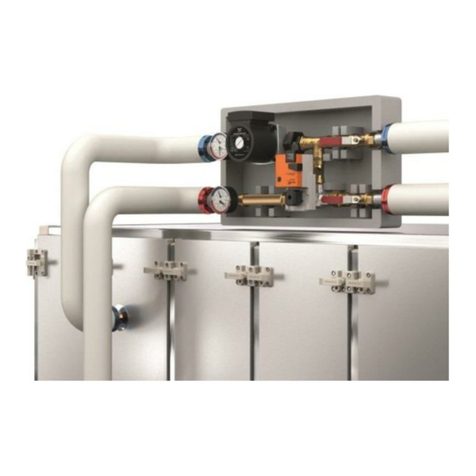
9
4. OPERATION AND MAINTENANCE
Start-up of the pump
Do not start the pump until the system has been filled with liquid and vented. Being self-venting, the rotor
can does not require venting before start-up. Air inside the pump will be transported by the medium into
the system during the first minutes after pump start-up.
The system cannot be vented through the pump. As the pump is self-venting, it does not need to be vented
before start-up. However, besides the smallest pump 25-70, it is recommended to vent pumps installed in
systems where the pumped medium is very dirty, as well as after service of the pump. The screw may be
loosened to check if the system has been vented completely.
When loosening the air-venting/de-blocking screw, be aware of hot, spraying water.
The operation of the pump depend on the type used in the water pump group (Table.3).
UPM3 25-70 Flex AS - The user interface is designed with a single push button, one red/green LED and four yellow LEDs.
The user interface shows:
• performance view (during operation)
–operation status
–alarm status
• settings view (after pressing the button).
During operation, the display shows the performance view. If you press the button, the user interface switches the view or runs in
the setting selection mode. The performance view shows either the operation status or the alarm status.
When the circulator is running, LED 1 is green. The four yellow LEDs indicate the current performance as the percentage of P Max.
(0- one LED green, 0-25% - one LED green + one yellow, 25-50 –one LED green + two yellow LED, and adequately for 50-75, 75-100.
When the operation mode is active, all active LEDs are constantly on in order to differentiate this mode from the select setting
mode. If the circulator is stopped by an external signal, LED 1 flashes green.
Alarm status
If the circulator has detected one or more alarms, the bi-colored LED 1 switches from green to red. When an alarm is active, the
LEDs indicate the alarm type as defined in the table below. If multiple alarms are active at the same time, the LEDs only show the
error with the highest priority. The priority is defined by the sequence of the table.
When there is no active alarm anymore, the user interface switches back to operation mode.
One red LED + one
yellow LED (LED 5)
Trying to start
again every 1.33
seconds.
Wait or deblock
the shaft.
One red LED +
one yellow LED
(LED 4)
Control the
supply voltage.
One red LED +
one yellow LED
(LED 3)
Pump is stopped
because of low
supply voltage or
serious failure.
Control the
supply voltage /
Exchange the
pump.




























